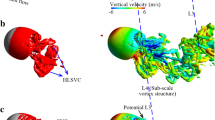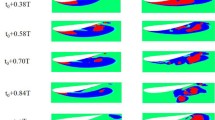Abstract
Cavitation is a complex multiphase flow phenomenon with an abrupt transient phase change between the liquid and the vapor, including multiscale vortical motions. The transient cavitation dynamics is closely associated with the evolution of the cavitation vortex structures. The present paper investigates the cavitation vortex dynamics using different vortex identification methods, including the vorticity method, the Q criterion method, the Omega method (Ω), the λ2 method and the Rortex method. The Q criterion is an eigenvalue-based criterion, and in the Omega method, the parameter is normalized, is independent of the threshold value and in most conditions Ω=0.52. The Rortex method is based on an eigenvector-based criterion. Numerical simulations are conducted using the implemented compressible cavitation solver in the open source software OpenFOAM for the sheet/cloud cavitating flows around a NACA66 (mod) hydrofoil fixed at α=6°, σ=1.25 and Re=7.96×105. The flow is characterized by the alternate interactions of the re-entrant flow and the collapse induced shock wave. Results include the vapor structures and the vortex dynamics in the unsteady sheet/cloud cavitating flows, with emphasis on the vortex structures in the cavitation region, the cavity interface, the cavity closure, the cavity wakes, and the foil wakes with the shedding cavity. The comparisons of the various methods, including that the vorticity method, the Q criterion method, the Omega method, the λ2 method and the Rortex method, show the performances of different methods in identifying the cavitation vortex structures. Generally, during the attached cavity growth stage, the Q criteria can well predict the vortex structures in the cavitation region and at the foil trailing edge in the pure liquid region, while with the Omega method and the Rortex method, the vortex structures outside the attached cavity and on the foil pressure side can also be predicted. The λ2 method can well predict the vortex structures in the cavity closure region. During the re-entrant jet development stage, the vortex structures in the re-entrant jet region is weak. During the cavity cloud shedding stage, the vortex dynamics at the foil leading edge covered by newly grown cavity sheet is different from that during the attached cavity sheet growth stage. During the shock wave formation and propagation stage, strong vortex structures with both the size and the strength are observed owing to the cavity cloud shedding and collapse behavior. The influence of the small parameter ε in the Omega method on the cavitation vortex identification is discussed.
Similar content being viewed by others
References
Wang G., Senocak I., Shyy W. et al. Dynamics of attached turbulent cavitating flows [J], Progress in Aerospace Sciences, 2001, 37: 551–581.
Wosnik M., Arndt R. Identification of Large Scale Structures in the Wake of Cavitating Hydrofoils Using LES and Time-Resolved PIV [C]. 26th Symposium on Naval Hydrodynamics, Rome, Italy, 2006.
Gopalan S., Katz J. Flow structure and modeling issues in the closure region of attached cavitation [J]. Physics of Fluids, 2000, 12(4): 895–911.
Wang C., Huang B., Zhang M. et al. Effects of air injection on the characteristics of unsteady sheet/cloud cavitation shedding in the convergent-divergent channel [J]. International Journal of Multiphase Flow, 2018, 106: 1–20.
Arndt R. E. A. Cavitation in vortical flows [J]. Annual Review of Fluid Mechanics, 2003, 34: 143–175.
Paik B. G., Kim K. S. et al. Test method of cavitation erosion for marine coating with low hardness [J]. Ocean Engineering, 2011, 38(13): 1495–1502.
Ganesh H., Mäkiharju S. A., Ceccio S. L. Bubbly shock propagation as a mechanism for sheet-to-cloud transition of partial cavities [J]. Journal of Fluid Mechanics, 2016, 802: 37–78.
Wang C., Huang B., Wang G. et al. Unsteady pressure fluctuation characteristics in the process of breakup and shedding of sheet/cloud cavitation [J]. International Journal of Heat and Mass Transfer, 2017, 114: 769–785.
Reisman G. E., Wang Y. C., Brennen C. E. Observations of shock waves in cloud cavitation [J]. Journal of Fluid Mechanics, 1998, 355: 255–283.
Ji B., Luo X., Arndt R. E. A. et al. Large eddy simulation and theoretical investigations of the transient cavitating vortical flow structure around a NACA66 hydrofoil [J]. International Journal of Multiphase Flow, 2015, 68: 121–134.
Ji B., Luo X., Arndt R. E. A. et al. Numerical simulation of three dimensional cavitation shedding dynamics with special emphasis on cavitation-vortex interaction [J]. Ocean Engineering, 2014, 87: 64–77.
Chang N. A., Choi J., Yakushiji R. et al. Cavitation inception during the interaction of a pair of counter-rotating vortices [J], Physics of Fluids, 2012, 24: 014107.
Iyer C. O., Ceccio S. L. The influence of developed cavitation on the flow of a turbulent shear layer [J]. Physics of Fluids, 2002, 14(10): 3414–3431.
Laberteaux, Ceccio S. L. Partial cavity flows. Part 2: Cavities forming on test objects with spanwise variation [J]. Journal of Fluid Mechanics, 2001, 431: 43–63.
Aeschlimann V., Prothin S., Barre S. et al. High speed visualizations of the cavitating vortices of 2D mixing layer [J]. European Journal of Mechanics — B/Fluids, 2012, 31: 171–180.
Pennings P., Bosschers J., Westerweel J. et al., Dynamics of isolated vortex cavitation [J]. Journal of Fluid Mechanics, 2015, 778: 288–313.
Gnanaskandan A., Mahesh K. Numerical investigation of near-wake characteristics of cavitating flow over a circular cylinder [J]. Journal of Fluid Mechanics, 2016, 790: 453–491.
Long X. P., Cheng H. Y., Ji B. et al. Large eddy simulation and Euler-Lagrangian coupling investigation of the transient cavitating turbulent flow around a twisted hydrofoil [J]. International Journal of Multiphase Flow, 2018, 100: 41–56.
Ji B., Long Y., Long X. P. et al. Large eddy simulation of turbulent attached cavitating flow with special emphasis on large scale structures of the hydrofoil wake and turbulence-cavitation interactions [J]. Journal of Hydrodynamics, 2017, 29(1): 27–39.
Wang C., Wu Q., Huang B. et al. Numerical investigation of cavitation vortex dynamics in unsteady cavitating flow with shock wave propagation [J]. Ocean Engineering, 2018, 156: 424–434.
Holmes P., Lumley J. L., Berkooz G. et al. Turbulence, coherent structures, dynamical systems and symmetry [M]. Cambridge, UK: Cambridge University Press, 2012.
Tang J. N., Tseng C. C., Wang N. F. Lagrangian-based investigation of multiphase flows by finite-time Lyapunov exponents [J]. Acta Mechanica Sinica, 2012, 28(3): 612–624.
Huang B., Zhao Y., Wang G. Large eddy simulation of turbulent vortex-cavitation interactions in transient sheet/cloud cavitating flows [J]. Computers & Fluids, 2014, 93: 113–124.
Dittakavi N., Chunekar A., Frankel S. Large eddy simulation of turbulent-cavitation interactions in a venturi nozzle[J]. Journal of Fluids Engineering, 2010, 132(12): 212301.
Zhao Y., Wang G., Huang B. et al. Lagrangian investigations of vortex dynamics in time-dependent cloud cavitating flows [J]. International Journal of Heat and Mass Transfer, 2016, 93: 167–174.
Epps B. Review of vortex identification methods [C]. 55th AIAA Aerospace Meeting, Grapevine, Texas, 2017.
Dong X., Tian S., Liu C. Correlation analysis on volume vorticity and vortex in late boundary layer transition [J]. Physics of Fluids, 2018, 30(1): 014105.
Dong X., Dong G., Liu C. Study on vorticity structures in late flow transition [J]. Physics of Fluids, 2018, 30(10): 104108.
Hunt J., Wray A., Moin P. Eddies, streams & convergence zones in turbulent flows [R]. Report CTR-S88, Center For Turbulence Research, 1988.
Chong M., Perry A., Cantwell B. A general classification of three-dimensional flow fields [J]. Physics of Fluids A: Fluid Dynamics, 1990, 2(5): 765–777.
Jeong J., Hussain F. On the identification of a vortex [J]. Journal of Fluid Mechanics, 1995, 332: 339–363.
Elsas J. H., Moriconi L. Vortex identification from local properties of the vorticity field [J]. Physics of Fluids, 2017, 29(1): 015101.
Liu C., Wang Y., Yang Y. et al. New omega identification method [J]. Science China Physics, Mechanics & Astronomy, 2016, 59: 684711.
Zhang Y., Qiu X., Chen F. et al., A selected review of vortex identification methods with applications [J]. Journal of Hydrodynamics, 2018, 30(5): 769–779.
Liu C., Gao Y., Tian S. et al. Rortex — A new vortex vector definition and vorticity tensor and vector decompositions [J]. Physics of Fluids, 2018, 30(3): 035103.
Tian S., Gao Y., Dong X. et al. A definition of vortex vector and vortex [J], Journal of Fluid Mechanics, 2018, 849: 312–339.
Gao Y., Liu C. Rortex and comparison with eigenvalue-based vortex identification criteria [J]. Physics of Fluids, 2018, 30(8): 085107.
Wang C., Huang B., Wang G. et al. Numerical simulation of transient turbulent cavitating flows with special emphasis on shock wave dynamics considering the water/vapor compressibility [J]. Journal of Hydrodynamics, 2018, 30(4): 573–591.
Leroux J. B., Astolfi J. A., Billard J. Y. An experimental study of unsteady partial cavitation [J]. Journal of Fluids Engineering, 2004, 126(1): 94–101.
Weller H. G. A new approach to VOF-based interface capturing methods for incompressible and compressible flow [R]. OpenCFD: 2008. Technique report TR/HGW/04.
Saito Y., Takami R., Nakamori I. et al. Numerical analysis of unsteady behavior of cloud cavitation around a NACA0015 foil [J]. Computational Mechanics, 2007, 40(1): 85–96.
Egorov Y., Menter F. R. Development and application of SST-SAS turbulence model in the DESIBER project [C]. Second Symposium on Hybrid RANS-LES Methods, Corfu, Greece, 2007.
Liu C., Gao Y., Dong X. et al. Third generation of vortex identification methods: Omega and Liutex/Rortex based systems [J]. Journal of Hydrodynamics, 2019, 31(2): 205–223.
Acknowledgements
This work is supported by the Open Foundation of State Key Laboratory of Ocean Engineering (Shanghai Jiao Tong University, China) (Grant No: 1611), and Open Fund for the Key Laboratory of Fluid and Power Machinery, Ministry of Education (Xihua University).
Author information
Authors and Affiliations
Corresponding author
Additional information
Project supported by the National Natural Science Foundation of China (Grant Nos. 51839001 and 91752105).
Biography: Chang-chang Wang (1992-), Female, Ph. D.
Rights and permissions
About this article
Cite this article
Wang, Cc., Liu, Y., Chen, J. et al. Cavitation vortex dynamics of unsteady sheet/cloud cavitating flows with shock wave using different vortex identification methods. J Hydrodyn 31, 475–494 (2019). https://doi.org/10.1007/s42241-019-0043-z
Received:
Revised:
Accepted:
Published:
Issue Date:
DOI: https://doi.org/10.1007/s42241-019-0043-z




